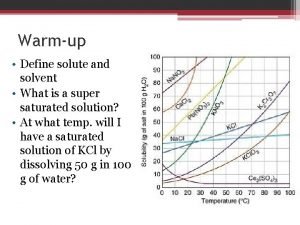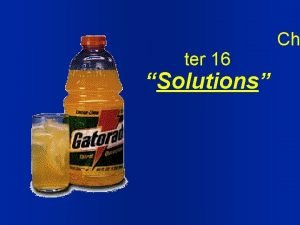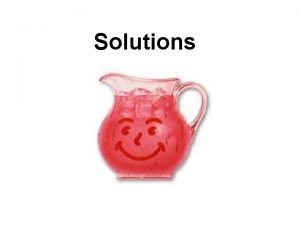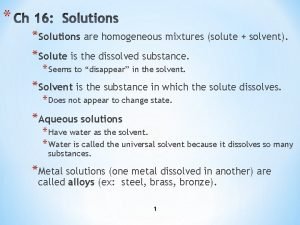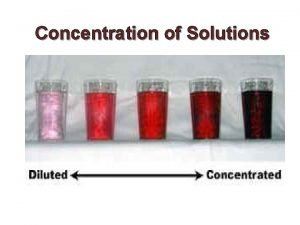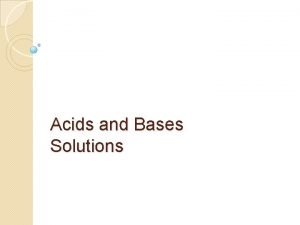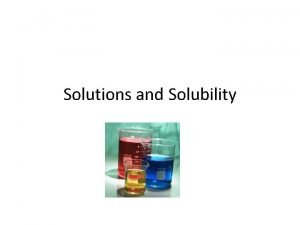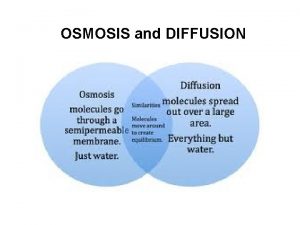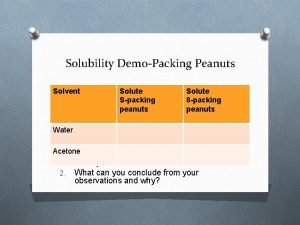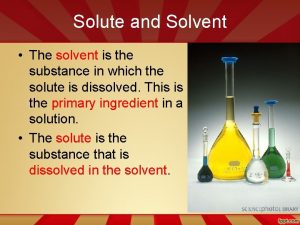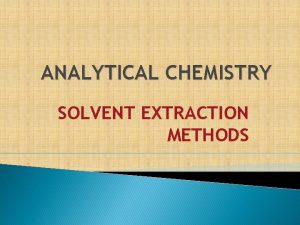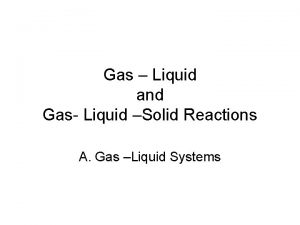Starter Solvent Solute Solution Solid Liquid Gas Melting













- Slides: 13

Starter: • Solvent • Solute • Solution • Solid • Liquid • Gas • Melting • Evaporation • Condensation • Element • Atom • Compound • Melting • Freezing • Sublimation

Learning Objectives • State the meaning of a saturated solution • Describe the meaning of solubility • Explain how temperature affects solubility • Work scientifically to study the link between temperature and solubility

Solutes, Solvents and Solutions A solute is a substance that dissolves in a solvent (e. g. sugar) A solvent is a substance that allows solutes to dissolve in it (e. g. water) A solution is formed when a solute dissolves in solvent.

Solubility 08/06/2021 In the scenario below, identify what the solvent, solute and solution are. Challenge: What is the definition for solvent, solute and solution

Different amounts of salt have been added to water and mixed. Challenge: Draw a particle diagram to show the arrangement of water and salt particles in the left image (use different colours) • Which solution do you think received the most salt? • The solution on the right is described as ‘saturated’ what could this mean? • What could you do to dissolve the excess salt in the picture on the right?

Copy down the diagram Challenge: Draw a diagram to show the arrangement of a saturated solution

A Saturated solution • At room temperature you can dissolve 200 g of sugar in a 100 m. L of water – 40 teaspoons! • However, if you add anymore it just falls to the bottom. • A saturated solution contains the maximum mass of a substance that will dissolve

Solubility • The mass of solute that will dissolve in 100 g of water is called its solubility • Every substance has its own solubility – some are insoluble 1. Which substance is the most soluble Lithium chloride 2. Which is the least soluble? Sodium chloride 3. Which has a solubility of around 73 g? Copper chloride

Learning checkpoint – Match up A saturated solution… Does not dissolve An insoluble substance Is the mass of substance that dissolves in 100 g of water Solubility Is a solution that contains the greatest mass of solid that can dissolve Stretch: What could the term supersaturation mean?

Design your practical – solubility of salt • Kris wants to find out about the amount of salt dissolved in seawater. • Design a practical investigation to find out whether the solubility of salt in seawater differs according to the temperature of the region.

How does temperature affect solubility? Temperature (o. C) 20 1. 2. 3. 4. Solubility of sugar (g/100 g of water) 202 40 60 236 289 80 100 365 476 What does the data show? How does solubility change with temperature Do your results align with your prediction How could you improve the accuracy and reproducibility of your results?

• Using the data from the practical, draw a sketch graph in your book. • Include a description of the graph

 Define solute and solvent
Define solute and solvent Solute vs solvent
Solute vs solvent Solvent vs solute
Solvent vs solute Solute vs solvent
Solute vs solvent Solute/solvent
Solute/solvent Quizlet
Quizlet Homogeneous mixture of a solute in a solvent
Homogeneous mixture of a solute in a solvent C2h6o
C2h6o Solute and solvent worksheet for grade 7
Solute and solvent worksheet for grade 7 Solute vs solvent
Solute vs solvent Solvent vs solute
Solvent vs solute Circle the solute and underline the solvent
Circle the solute and underline the solvent Sweet tea solute and solvent
Sweet tea solute and solvent A measure of the amount of solute dissolved in a solvent
A measure of the amount of solute dissolved in a solvent
